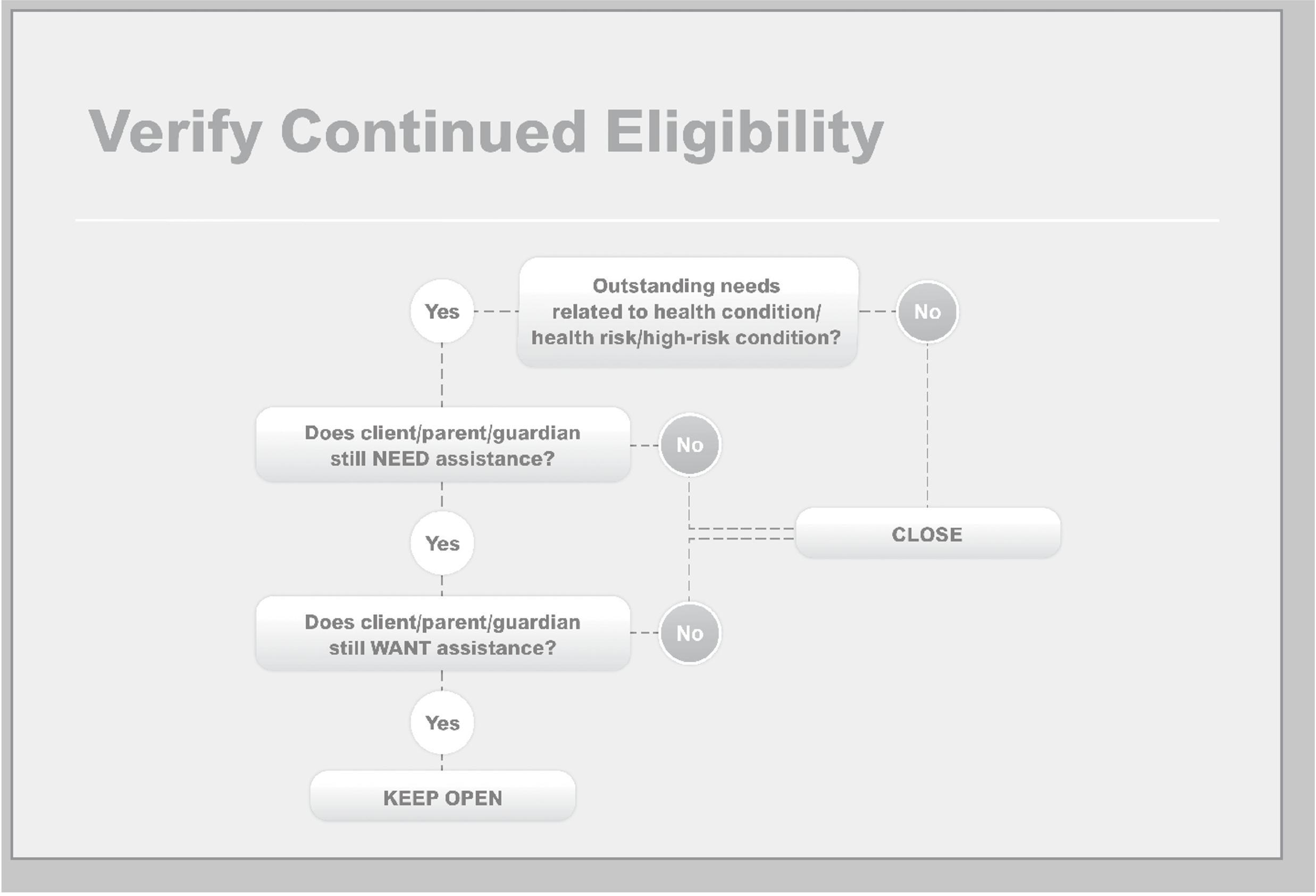Follow-Up Visits
(includes documentation of continued eligibility and required documentation and progress notes)

After completing the Comprehensive Visit, you may need to schedule a follow-up visit with the client, parent or guardian.
During the follow-up visit, you will:
- Review each need listed on the Service Plan (SP).
- Provide referrals or problem-solve with the client, parent or guardian on how to address each need.
- Ask the client, parent or guardian if they had any barriers or issues with referrals you provided.
- Inquire whether there are any new needs.
Follow-up visits must be conducted:
- In-person or synchronous audiovisual or by phone.
- As authorized by TMHP. All follow-up visits will be automatically authorized by TMHP as face-to-face unless you specifically request phone follow-up visits.
- Phone follow-up visits cannot be billed as face-to-face.
Follow-up visits are billable if all of the following are completed:
- The client has needs related to their health condition or health risk.
- You assist the client, parent or guardian in addressing those needs.
- All needs on the SP have been reviewed.
At the end of the first follow-up visit, you must assess the needs and determine whether:
- The client still has needs related to their health condition/health risk or high-risk condition, and
- The client, parent or guardian continues to want case management.
If the client answers yes, you would schedule another follow-up visit with the client, parent or guardian. If the remaining needs are global family needs, you cannot bill for another follow-up visit. Global family needs may include, for example, referrals to food banks, housing, clothing, school supplies and baby items.
Continued Eligilibility Verification Flowchart

Review the SP with the family at each follow-up visit to determine which needs remain and which have been addressed.
- Does the client still have current outstanding needs related to their health condition/health risk or high- risk condition?
- Are the only needs remaining global needs or needs related to other family members?
- Are the client’s needs anticipatory? All needs must be current.
- Does the client still need assistance with gaining access to necessary medical, social, educational, and other services related to their health condition/health risk or high-risk condition?
- Does the client, parent or guardian still want assistance with gaining access to necessary medical, social, educational, and other services related to their health condition/health risk or high-risk condition?
Follow-Up Visit and School Meeting
If the client, parent or guardian is asking you to attend a school meeting, you may conduct a follow-up visit before or after it. For the visit to be billable, you must meet with the client, parent or guardian to review the Service Plan before or after the school meeting. Attending only a school meeting is not a billable visit.
New Needs Reported During a Follow-Up Visit
If the client, parent or guardian reports they have a new need related to the client’s health condition/health risk or high-risk condition, you will document the new need on an SP form and check the addendum box. You will indicate the tasks and timeframes on this form. A new Service Plan Consent Form (CM-03Con) needs to be completed and signed by the client, parent or guardian.
New Needs and Request for Additional Visits
If all visits have been used and the client needs additional visits, you can request additional visits by submitting a Request for Additional Visits (F00187) on the TMHP PA on the Portal.
Additional visits:
- Cannot be requested until previously approved visits have been used.
- Should be requested if the client still meets eligibility requirements and the client and case manager agree more visits are necessary to meet needs.
Your request must include documentation about whether the need was identified on the Initial Request for Prior Authorization and reasons you need additional visits to address it.
Non-Billable Follow-Up Activities
Follow-up activities may include both billable and non-billable activities.
These include activities between billable follow-up visits made to assist in addressing the client’s needs. They may include collateral contacts with the following entities:
- Medical and behavioral health providers
- Government agencies
- Community resources
- Schools
- MCOs
- DME providers
- Medical Transportation Program (MTP)
Some of these collateral contacts can also occur during a billable visit with the client, parent or guardian present and you modeling what questions to ask and how to access resources.
All non-billable activities must be documented in progress notes or, if made during a follow-up visit, must be documented on the follow-up visit form.
Follow-Up Visit Documentation
- Each need should be bulleted.
- Each need should document the current status and actions taken or needed.
- Each follow-up visit should be individualized.
- The time between each follow-up visit should be reasonable and based upon the urgency of the needs. Please review Adam’s second follow-up visit in the Complete Case Record section.
Client Status Form (CM-08)
This form should be used when you will not be seeing the client because of the reasons listed on the form; for example, that the client’s needs have all been addressed. This document could also be used when you cannot contact the client and they are lost to follow-up. You would complete this form when all visits have been used and there are no current needs.
Documentation and Progress Notes Expectations
Documentation Requirements: Medicaid Policy
All entries must:
- Be legible, dated and signed with the appropriate credentials of the case manager.
- Contain the client’s name and Medicaid number.
- Ensure that all services are clearly documented in the record to support the continued need for services.
- Include the timeframe for the next follow-up visit.
Resources
For more information about Medicaid Provider responsibilities, refer to the Texas Medicaid Provider Procedures Manual (TMPPM) at the Texas Medicaid & Healthcare Partnership (TMHP) website, tmhp.com.
Documentation Requirements: CM Rule and Policy
- Document all case management activities.
- The documentation MUST support eligibility.
- Use required HHSC forms.
- Use progress notes.
- Complete forms in the client’s preferred language (or signed by a translator or interpreter).
Keep Documentation Up To Date
Because you are a Medicaid provider, your client records are subject to audit and may be requested at any time; therefore, your documentation should be kept up to date.
How to Organize Client Records
Organizing your client records is subject to personal preference. However, the following documents must be maintained in each client record:
- Initial Prior Authorization Request (F00186) or the required process by the client's MCO
- Response to Request for Prior Authorization from TMHP or the client's MCO
- FNA (CM-02)
- Migrant Information Form (CM-02A), if applicable
- SP (CM-03)
- SP Consent (CM-03 Con Sig)
- Service Plan Addendum (CM-03)
- Follow-up Forms (CM-04)
- Case Transfer (CM-09), if applicable
- Client Status Form (CM-08)
- Prior Authorization for Additional Visits (F00187), if applicable
- Request to Change Authorization to Another CM is entered as a Change of Provider on TMHP.com, if applicable
- Progress Notes (CM-05)
- Acknowledgment and Receipt of HIPAA Notice
- Authorization to Disclose Protected Health Information (CM-12)
Note: you must produce paper copies of electronic records when requested.
Electronic Records
Avoid storing protected health information on removable media, including USB drives and other external removable media such as non-rewritable CDs.
- If it cannot be avoided, use USB devices with encryption capability.
- If you store data on a CD-R, ensure that the file is encrypted and password protected.
Record Retention
Per Medicaid policy, providers must:
- Maintain and retain all documents related to the case.
- Retain records for five years.
- Provide copies of records to any state or federal agency authorized to conduct compliance, regulatory or program integrity activities.
Resources
For more information, review the TMPPM: Retention of Records and Access to Records and Premises by downloading the TMPPM at tmhp.com


